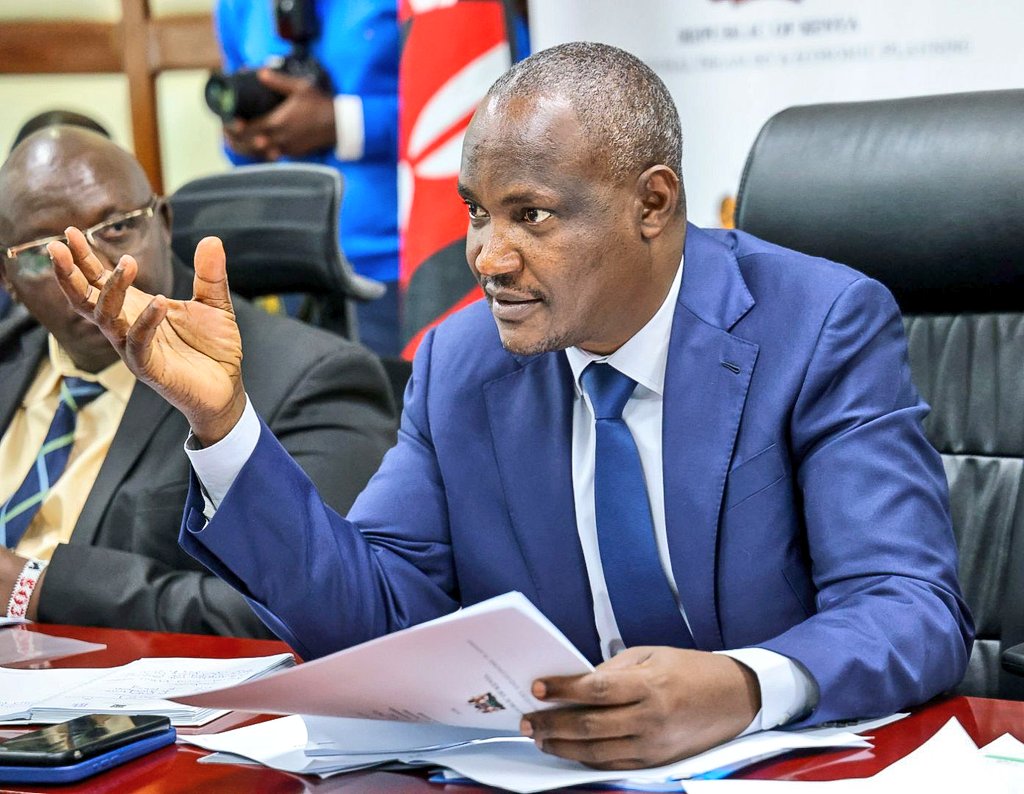
As a result, oil pump prices have been dropping steadily. The inflation rate has dropped from a high of 9.6 per cent in 2022 to 3.6 per cent in September 2024 and is expected to remain below five per cent into 2025.
Lower inflation means prices are not rising fast. In some cases, the prices have come down, for example, sukuma, unga (maize), chapati flour, sugar, petrol, diesel and kerosene, pushing down the cost of living.
National Treasury Cabinet Secretary John Mbadi highlighted the role of strategic government actions in stabilising the shilling.
He credited the easing of foreign exchange volatility to several key measures, including the buyback of the inaugural $2 billion Eurobond earlier this year, effective monetary policies and a new Government-to-Government oil procurement strategy.
According to the Treasury, each unit rise in the shilling against the US dollar results in a reduction of external debt by Sh40 billion.
As of Wednesday, the shilling was trading at 128.70 units against the dollar, having appreciated by 30 units since February when it reached a historic low of 160 units.
This stability has contributed to a drop in the debt-to-GDP ratio from a concerning 73 per cent to a more manageable 67 per cent, even though the total public debt remains at Sh10.6 trillion.
“The impact of an appreciating shilling goes beyond simply lowering debt pressure. Had this administration not made tough decisions, our debt-to-GDP ratio could have exceeded 80 per cent, which would indicate a risk of default,” Mbadi explained.
He noted that the stronger currency has also contributed to lower costs of living, particularly in electricity and fuel prices.
In February, Kenya took a proactive approach by tapping into the international bond market to raise funds and repurchase its maturing $2 billion Eurobond.
The new bond, valued at $1.5 billion and maturing in 2031, was oversubscribed four times, indicating strong investor confidence.
The yield of 10.375 per cent was lower than the anticipated 11per cent, helping to relieve pressure on the local currency, which had been predicted to potentially drop to 200 units against the dollar.
In addition to these financial manoeuvres, President William Ruto’s government executed a strategic shift in oil imports last year, moving from the Open Tender System to a Government-to-Government arrangement.
This new framework allows local oil marketers to receive fuel on credit from major suppliers such as Emirates National Oil and Saudi Aramco for up to six months.
Once the fuel is received, it is sold in shillings, with payments held in escrow accounts managed by local banks.
Daniel Kiptoo, director general at the Energy and Petroleum Regulatory Authority (EPRA), shared that this arrangement has significantly reduced the monthly demand for US dollars in the petroleum sector by $500 million, easing pressure on the country’s foreign exchange reserves.
The Central Bank of Kenya also played a crucial role in stabilising the currency by implementing a significant interest rate hike in December.
National Treasury Principal Secretary Chris Kiptoo noted that while the initial increase in base-lending rates indicated higher costs for borrowers, the long-term benefits of a stable shilling outweighed these concerns, leading to lower inflation and borrowing costs.
Looking ahead, Kiptoo outlined the government’s strategy to further enhance economic stability.
He emphasised the importance of budget consolidation, Public-Private Partnerships (PPPs) and efficient domestic revenue-raising mechanisms to mitigate debt vulnerability.
“We are working on a predictable tax policy to eliminate the need for annual Finance Bills and to phase out costly infrastructure bonds and commercial loans,” he stated.
The goal is to stabilise the debt-to-GDP ratio at 55 per cent by 2028. However, challenges remain.
Earlier this year, international credit rating agencies downgraded Kenya’s borrowing power after the government opted for expenditure cuts instead of tax increases in response to public protests against the Finance Bill, 2024.
Moody’s Investors Service noted that the negative outlook reflected risks related to government liquidity.
“Our updated forecasts continue to assume a narrowing of the fiscal deficit through spending cuts, but at a more gradual pace than previously expected,” the agency reported.
They also cautioned that slower fiscal consolidation could limit external funding options and reduce support from multilateral creditors, who have been essential to Kenya’s financing since 2020.
Last week, as part of the approval process for Kenya’s delayed $606 million (Sh78.2 billion) loan, the International Monetary Fund urged President Ruto’s administration to implement reforms aimed at creating a more efficient, equitable and progressive tax regime.
They called for improvements in the accountability, transparency and efficiency of public finances.
In response, the National Treasury has assured the public that measures to enhance economic stability and ensure sustainable debt levels are in the pipeline, with a commitment to achieving debt stability by the end of Ruto’s first term.











